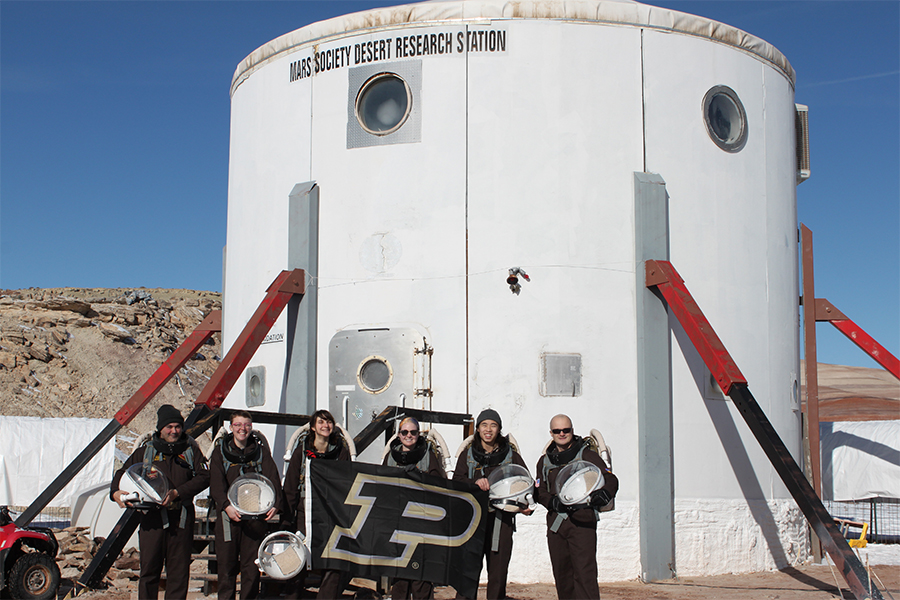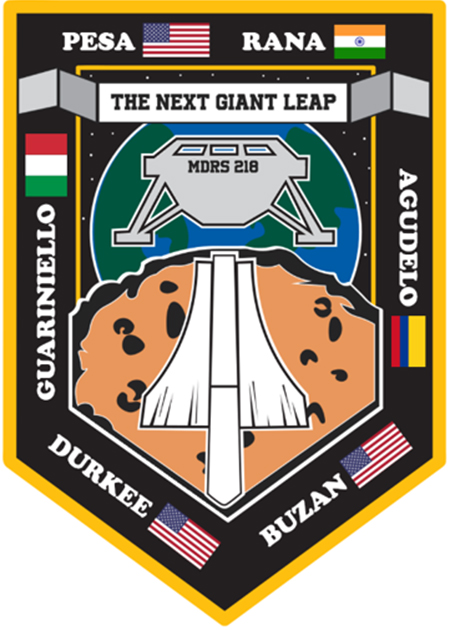Another winter break, another analog mission for AAE alum

The primary purpose is significant and straight forward.
Cesare Guariniello has aspirations of becoming an astronaut, so he seeks out any experience that offers relevant training.
The Mars Desert Research Station does exactly that, selecting teams for an analog mission in a remote, confined habitat near the Henry Mountains in southeast Utah.
So, for the third consecutive year, Guariniello will be part of a Purdue team that will visit MDRS. The six-member crew will spend 16 days, spanning over Christmas and New Year’s, in the station that includes a small two-story habitat, an astronomical observatory, a scientific laboratory and a greenhouse. MDRS, operated by The Mars Society, is one of only a few Mars simulation environments in the world.
Guariniello, a research scientist in the School of Aeronautics and Astronautics and an AAE alumnus, will be commander again this year after first serving in that capacity last year with the “MartianMakers” Purdue team. With the “Boilers2Mars” group in 2017-18, he was crew geologist.
Though Guariniello wasn’t initially expecting to be commander this year, he didn’t hesitate when presented the surprising opportunity: How could he turn down another chance to improve his resume?
“Analog missions are a good way to prepare — or at least check to see if one is capable of doing something or where to work a little bit,” he said. “Like, ‘Hey, I could have been a little more patient on that.’
“I love it. Every year brings new challenges. I’ve seen a difference between the first and second year. I love to be there and be the veteran to show them how it is.”

Guariniello is the only returning participant on this year’s crew, MDRS-218, "The Next Giant Leap." He’ll be joined by a pair of current AAE students, Benjamin Durkee (crew journalist) and Pat Pesa (crew geologist), as well as Purdue alumni Jonathan Buzan (PhD EAPS ’18, crew scientist) and Shefali Rana (MSIE ’18, health and safety officer) and current doctoral student in mechanical engineering, Luz Maria Agudelo (MSCE ’18, crew engineer).
The crew will conduct research centered on “technology in support of human exploration and human factors.” Of his own volition, Guariniello is allowing his medical data to be recorded for further evaluation, in cooperation with Barrett Caldwell, a professor in industrial engineering and courtesy in AAE. He’ll share details on heart rate, blood pressure and, depending on if there’s a scale in the habitat, body weight. He’ll also provide information on hydration, fatigue and stress level. That’s all in an effort to better understand the impact of comfort and isolation on performance and decision-making processes during EVAs, among other things.
Guariniello personally is interested in such research and hopes to be able to get a full-screening suit for the next analog mission.
“It’s one of the biggest tasks of astronauts, being subject to medical research,” he said. “They do a lot of research, especially for biology, and then they are subject to research. Most of the times, if you see the daily schedule for the International Space Station, there’s at least one crew member who has to (have a) medical sample for this experiment or make this reading or fill out this questionnaire. Then they have a lot after the mission because they get so many more exams after the mission to see what happened to the body.”
For Guariniello, collecting that kind of data only enhances the realism of the MDRS experience. His work with Caldwell also builds on recently completed NASA analog research known as BASALT, looking at geology science return and human factor issues for Mars analog EVAs in Idaho and Hawaii.
So EVAs are a major analog research emphasis. The MDRS crew will perform EVAs as long as six miles and five hours per day, leaving the habitat to perform research. The weather can be an issue — it dropped below freezing and snowed last year — and rough conditions could mean Guariniello makes tough calls as commander. Precipitation can mean mud, and mud can be difficult to navigate.
But, at least, Guariniello has experimental knowledge of the role now and of the experience as a whole.
“There were many good things, and there were also hard challenges, difficult aspects,” Guariniello said of the first two years, “including spending the holidays away from everybody except for five people. That’s a toll, too. Isolation, I don’t dislike it, but it’s not easy because I’m a very social person.
“I think the pros very much outweigh the cons. I think it’s a very good experience for me, it’s a very good experience for people who are there, it’s very good for Purdue.”
